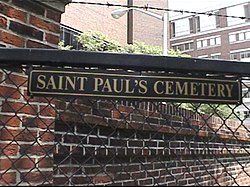Old Saint Paul's Cemetery
|
St. Paul's Cemetery
|
|

Old Saint Paul's Cemetery
|
|
| Location | Redwood Street and Martin Luther King Blvd., Baltimore, Maryland |
|---|---|
| Coordinates | 39°17′15″N 76°37′41″W / 39.28750°N 76.62806°WCoordinates: 39°17′15″N 76°37′41″W / 39.28750°N 76.62806°W |
| Area | 2.4 acres (0.97 ha) |
| NRHP Reference # | 88000746 |
| Added to NRHP | June 30, 1988 |
Old Saint Paul's Cemetery is a cemetery located in downtown Baltimore, Maryland, United States. It is noted for the several important historical figures that are interred in its grounds.
It was listed on the National Register of Historic Places in 1988.
The first cemetery of Saint Paul's Church (Protestant Episcopal) in Baltimore was located at the future intersection of Sollers Road and North Point Road in what is now the area of Dundalk in southeastern Baltimore County. The original small church of St. Paul's Parish of the established Church of England was one of the "Original Thirty" parishes designated for the colonial Province of Maryland and was founded in 1692 and considered to be the first and oldest church in Baltimore County and City and one of the oldest in the State. In 1730, the Parish Church of St. Paul's was moved from near Colgate Creek on the "Patapsco Neck" peninsula to the new burgeoning town of Baltimore overlooking "The Basin" at the head of the Patapsco River on its Northwest Branch, and Lot #19 was purchased in the "Original Survey" of that year by county surveyor Phillip Jones from Charles Carroll of Annapolis.
As the designated parish for the new Baltimore County, which then included most of northeastern Maryland when it was "erected" (established) in 1659, the first St. Paul's was located around the vicinity of the lower Colgate Creek which flowed into the Patapsco River and is assumed that the cemetery would be located somewhere nearby. The small earlier "county seat" for the new County was "old Joppa", located in the middle portion then of what was the "Old County" (including modern Baltimore City and County, Harford, Cecil, Carroll, and portions of Anne Arundel, Howard and Kent Counties), now in the vicinity of the post-Second World War suburban development of "Joppatowne" and an earlier "Baltimore" located on the Bush River, until the county seat was moved in 1767-68to the new burgeoning "Baltimore Town", with a flourishing port established in 1706, and a small town laid out in 1729-30.
...
Wikipedia



